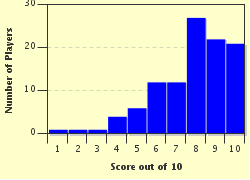Quiz Answer Key and Fun Facts
1. Let's begin our journey! As we sail toward Latvia from the West, we float along the Baltic Sea, through the Irbe Strait and into what gulf, named after the capital city?
2. Whilst we are in the capital of Latvia, we'll see some of the sights! But which of these is NOT on our itinerary?
3. One item on our itinerary is a boat-ride up and down the river that runs through the middle of Latvia. What is the name of this river?
4. One of Latvia's most vital resources is its abundant rivers. Included in your boat-ride is a tour of Latvia's hydroelectric dams, truly modern wonders. Which of these, however, will we not see, because public demonstrations prevented its construction?
5. Having finished our boat-ride, we'll finish our trip on land. Strap on your gear; we're going to climb up to the highest point in Latvia. What is it?
6. Now we can walk a nature trail and have a picnic lunch in a beautiful park that holds a third of all Latvian natural preserves, not to mention more than 500 monuments! What is this gorgeous greenspace?
7. As we travel through Latvia, you'll notice that one kind of biome predominates. What is it?
8. Unfortunately, you may have noticed on your trip that Latvia suffers from a few environmental issues. Which is NOT among them?
9. Modern industrialization and environmental problems notwithstanding, Latvia has a long history of nature conservancy.
10. Now follow me into our last area to visit. Shh! You can see all kinds of animals here if you are quiet, including the black stork, Eurasian beaver, Eurasian otter, and lesser spotted eagle, which are uncommon in the rest of Europe. What events, normally seen as negative economically, led to the development of areas where these rare creatures could flourish?
Source: Author
gracious1
This quiz was reviewed by FunTrivia editor
Pagiedamon before going online.
Any errors found in FunTrivia content are routinely corrected through our feedback system.
